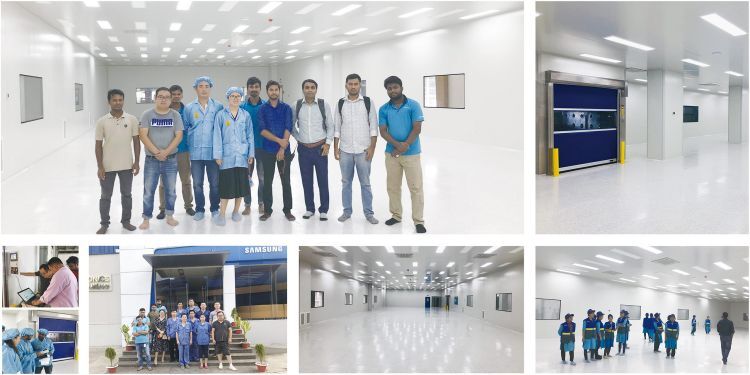Clean Room Solutions: Ensuring Optimal Hygiene in Sensitive Environments
- 2024-05-27
- View 11
Clean rooms are highly controlled environments designed to maintain low levels of airborne contaminants, particles, and microbes. These specialized spaces are crucial for industries where even the tiniest contamination can have severe consequences Clean room solutions ensure the optimal functioning of these environments by incorporating cutting-edge technologies and protocols to maintain cleanliness and hygiene.

1. Understanding Clean Rooms
A clean room is a controlled environment that is constructed to limit airborne particles and contaminants. It offers a highly sterile and controlled space, making it ideal for industries that require precision and cleanliness in their operations.
2. Importance of Clean Room Solutions
Clean room solutions play a vital role in various industries, ensuring the integrity of products and processes. They are particularly critical in industries such as pharmaceuticals, electronics, biotechnology, and healthcare, where precision and cleanliness are non-negotiable.
3. Components of Clean Room Solutions
Clean room solutions encompass various elements that work together to create and maintain a pristine environment.
3.1. Controlled Environment
Clean rooms maintain a strict control over environmental factors, including temperature, humidity, and air pressure, to minimize the presence of contaminants.
3.2. Air Filtration Systems
High-efficiency air filtration systems are utilized to remove particles and microorganisms from the air, ensuring a clean and sterile environment.
3.3. Wall and Ceiling Systems
Clean room walls and ceilings are designed to be smooth and easy to clean, preventing the accumulation of particles and bacteria.
3.4. Clean Room Furniture and Equipment
Furniture and equipment used within clean rooms are made of materials that are easy to clean and resistant to contamination.
4. Designing a Clean Room
Designing an effective clean room requires careful consideration of several key factors.
4.1. Classifications and ISO Standards
Clean rooms are classified based on the maximum allowable particle count per cubic meter. ISO standards provide guidelines for cleanliness and performance requirements.
4.2. Layout and Workflow
The layout of a clean room should facilitate a smooth workflow while minimizing cross-contamination risks.
4.3. Material Selection
Materials used in clean room construction should be non-porous and resistant to microbial growth.
4.4. HVAC Considerations
The Heating, Ventilation, and Air Conditioning (HVAC) system plays a crucial role in maintaining air quality within the clean room.
5. Implementing Clean Room Solutions
Implementing clean room solutions requires the establishment of robust protocols and practices.
5.1. Clean Room Personnel Training
Personnel working in clean rooms need thorough training on hygiene practices and adherence to standard operating procedures.
5.2. Standard Operating Procedures (SOPs)
SOPs ensure consistent and standardized operations within the clean room environment.
5.3. Regular Maintenance and Monitoring
Regular maintenance and monitoring are essential to ensure that the clean room remains in optimal condition.
5.4. Contamination Control Strategies
Contamination control strategies are implemented to minimize the introduction and spread of contaminants.
6. Industries Utilizing Clean Room Solutions
Clean rooms find applications in several industries that require strict environmental control.
6.1. Pharmaceuticals and Biotechnology
Pharmaceutical and biotechnology companies use clean rooms for drug development, manufacturing, and research to ensure product purity.
6.2. Electronics and Semiconductors
Clean rooms are crucial in the electronics industry, where even tiny particles can disrupt delicate manufacturing processes.
6.3. Healthcare and Hospitals
Clean rooms are utilized in hospitals for surgical procedures, compounding sterile medications, and research.
6.4. Aerospace and Defense
In aerospace and defense, clean rooms are used for assembling sensitive equipment and satellite components.
7. Advantages of Clean Room Solutions
The incorporation of clean room solutions brings numerous benefits to industries and processes.
7.1. Product Quality and Integrity
Clean rooms ensure that products meet stringent quality standards, reducing the likelihood of defects and recalls.
7.2. Regulatory Compliance
Clean rooms help industries adhere to strict regulatory requirements for cleanliness and product safety.
7.3. Enhanced Safety for Personnel
Personnel working in clean rooms benefit from a safe and controlled working environment.
7.4. Extended Equipment Lifespan
Clean rooms can extend the lifespan of sensitive equipment by reducing wear caused by contaminants.
8. Challenges and Considerations
While clean rooms offer numerous advantages, there are challenges that need to be addressed.
8.1. Cost of Implementation
Setting up and maintaining clean rooms can involve significant initial costs.
8.2. Maintaining Cleanliness
Continuous efforts are required to uphold the cleanliness and sterility of the clean room environment.
8.3. Changing Technology and Upgrades
As technology evolves, clean rooms may require periodic upgrades to remain efficient and up-to-date.
9. Future Trends in Clean Room Solutions
Advancements in technology and processes will continue to shape the future of clean room solutions. This may include the integration of automation and robotics for improved efficiency and precision.
10. Conclusion
Clean room solutions are indispensable in industries that demand uncompromising cleanliness and precision. From pharmaceuticals to electronics, these controlled environments safeguard product quality, personnel safety, and regulatory compliance. By combining cutting-edge technologies and strict protocols, clean room solutions ensure the highest level of hygiene and control in sensitive environments.
11. FAQs
Q: What is a clean room?
A: A clean room is a highly controlled environment designed to minimize airborne contaminants and particles.
Q: What industries use clean room solutions?
A: Industries such as pharmaceuticals, electronics, healthcare, and aerospace utilize clean room solutions.
Q: Why are clean rooms important in pharmaceuticals?
A: Clean rooms ensure product purity and safety, critical in drug development and manufacturing.
Q: How can clean rooms enhance product quality?
A: By minimizing contamination risks, clean rooms reduce the likelihood of defects and improve product quality.
Q: What is the future of clean room solutions?
A: The future of clean room solutions may involve integrating automation and robotics for increased efficiency and precision.
Kwang Cleanroom is proud to offer examples of a variety of our cleanroom projects below. Cleanroom Design and Build, Biopharmaceutical Cleanroom, Germfree Cleanroom, Class 10000 Clean Room, Design of Dust-Free Clean Room, Medical Device Clean Room, Hospital Operating Clean Room.
